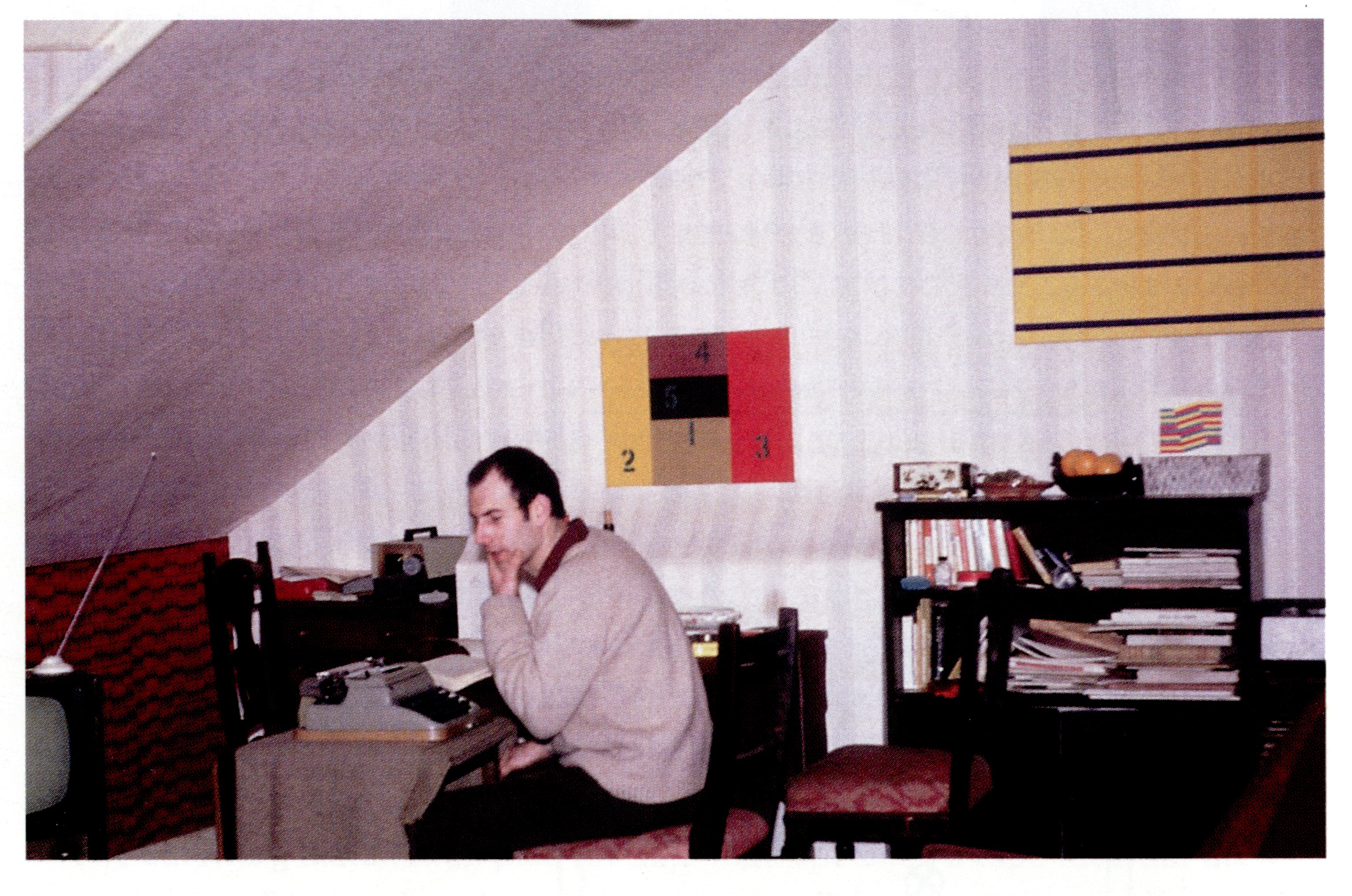
Ian Burn et al. is a long research query focusing on the legacy of Ian Burn, and the work of his network of peers. A series of public events, publications and writing follows:

Ian Burn et al. is a long research query focusing on the legacy of Ian Burn, and the work of his network of peers. A series of public events, publications and writing follows:
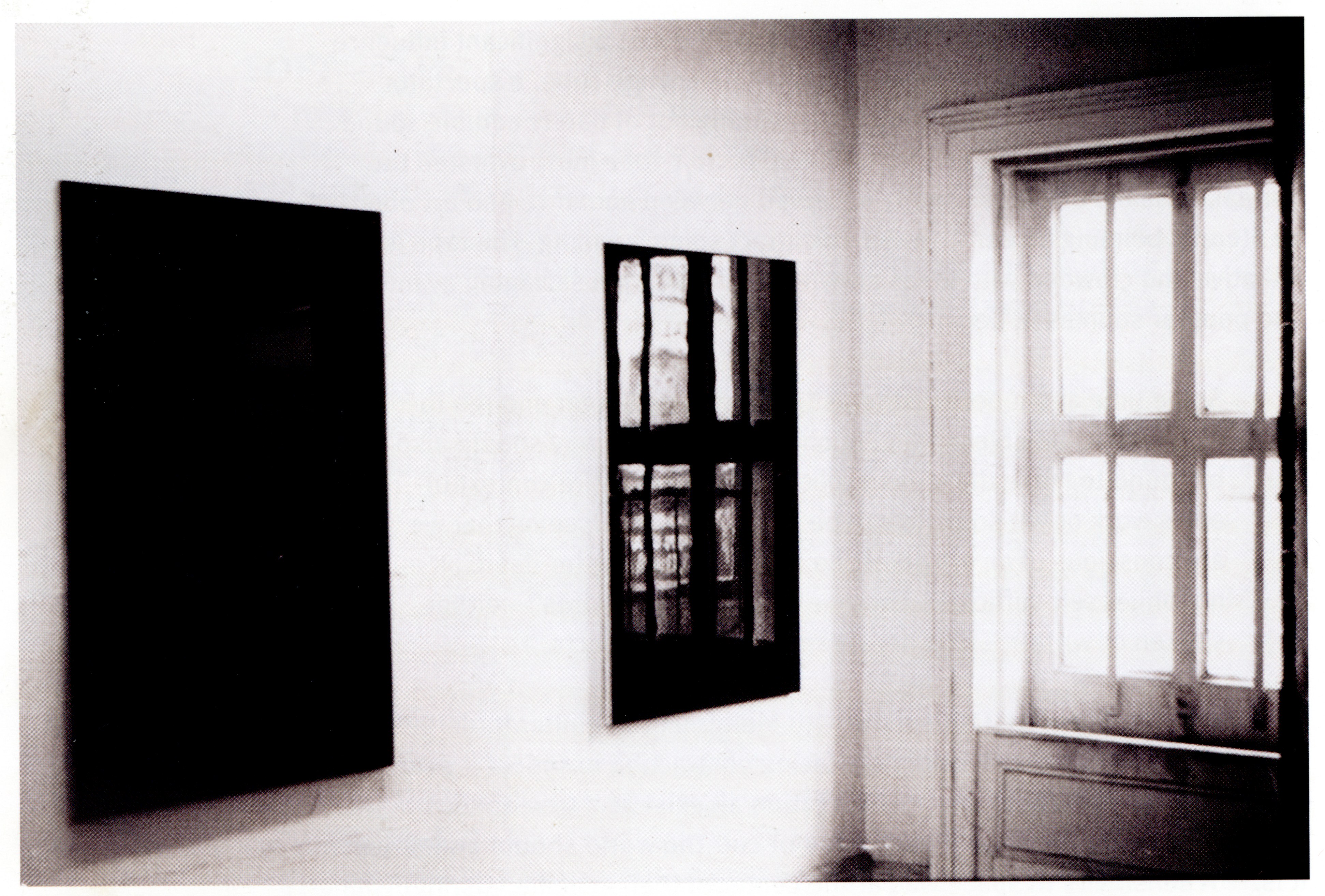
In 1996, Adrian Piper wrote and delivered a lecture memorialising the achievements of fellow artist Ian Burn. Delivered just after Burn’s untimely death, this text was perhaps the first public approach at considering Ian Burn’s lifework in total. Piper does not hesitate to take on the seriousness of Burn’s propositions, and in the acute and clear manner that we know her for, she rereads Ian Burn’s “conceptualism” from the perspective of his own theoretical frame.
Like Burn, we should also note that Piper’s writing can be considered within the logic of her output as an artist. Suitably, the two met through publishing in the conceptual art journal The Fox, which Burn co-edited. As she recounts in the following text, they met in New York (just once) in 1975 after Piper had written a response to Burn’s article from the first issue of The Fox, titled “Pricing Works of Art”. Six years prior, they had shared pages in July 1969, a conceptual art publication co-published by Art Press Inc. and The Society for Theoretical Art and Analyses [Ian Burn, Mel Ramsden, and Roger Cutforth], but did not meet in person until Burn took Piper to task for her response to his article, titled “A Proposal for Pricing Works of Art", published in the follow up issue.
(From Other Than Art's Sake, printed in transcript form as "Interview with Adrian Piper", Peter Kennedy in Lip, 1976)
Ian Burn's Conceptualism, by Adrian Piper 1
Ian Burn was an Anglo-Australian artist best known for his participation in the New York branch of Art & Language, a Conceptual art collective that flourished in the early 1970s. The New York branch of this group exhibited and published, most notably in The Fox, Marxist analyses of power relations, commodity production, and exchange within the art world. It also composed, performed, recorded, and videotaped some extremely funny rock-and-roll songs with revolutionary lyrics that often quoted from Marx.
But Burn had an artistic career both before and after this period. Before, his work evolved from early traditional landscapes and self-portraits into increasingly abstract and, beginning in 1965, Minimalist paintings. These led to Conceptual art works and installations that then motivated his participation in the Art & Language group. After Art & Language disbanded in New York, he seemed to disappear from the international scene. In fact he returned to Australia in 1977 to work for the Australian Labour Movement through a small company, Union Media Services. There he organised cultural programming for trade union members, curated exhibitions of their work, and wrote related essays and commentaries, as well as publishing articles on Anglo-Australian landscape painting and on the Aranda (Arrernte) Aboriginal artist Albert Namatjira. In addition, he was well known as a careful and demanding writer and curator of contemporary art and unofficial advisor to several dissertations in aesthetics and art history at local universities.
It transpires that after work at his day job, he was also resuming the production of art objects himself, and indeed returned to landscape painting - but through a singular process: he went about collecting amateur landscape paintings, sometimes signed but often anonymous, which he purchased in junk shops. He then composed and printed on plexiglass lyrical and associative texts for each, which he superimposed in front of the painted surface. And shortly before he drowned in an accident in 1993, he completed a series based on his own very early amateur landscapes, which he then overpainted with paradoxical and philosophical texts he had composed for them.
I feel it is tremendously important to look more extensively at Ian's late work, as well as the early work he did before he became a member of the Art & Language group, which was when I met him. Rather than discuss the correspondences between Ian's work and my work in terms of the themes we shared in common - social commitment, a sense of locatedness with regard to political circumstance, as well as our interest in Conceptual art - I would like to consider his practice in terms of its unity and conceptual consistency as a whole.
So, in this text I take issue with Ian for the second time. The first time was in 1975, the first and only time we actually met. He had published an essay, "Pricing Works of Art," in The Fox, no. 1. In response I'd published "A Proposal for Pricing Works of Art" in The Fox, no. 2. Ian called and suggested we discuss it the next time I was in New York (I had recently moved to Cambridge, Massachusetts, to take up graduate study in philosophy). We met in his loft; I recall that Mel Ramsden, one of the early members of Art & Language, was also there. Ian was very stern and severe. He accused me of not having really addressed the issues. Actually he was right. I hadn't really addressed the issues he'd raised in his essay. At that time I just hadn't had enough exposure to the art market side of the art world to think subtly about it, so my essay was very abstract. But of course I wasn't going to admit that to him. So we had quite a spirited discussion. He was intellectually rigorous and morally uncompromising in his arguments. I thought I'd escaped that for a few days by getting out of Cambridge, but I was wrong.
So now I want to argue with Ian again, and in particular with his claim that Conceptual art failed because of the internal contradictions it generated. Here's what he says in "The 1960s: Crisis and Aftermath," written in 1981: "The most significant thing that can be said to the credit of Conceptual art is that it failed ... to fulfill certain initial expectations and ideals, and its goals were in many ways unattainable.... For those who took the inevitable steps beyond Conceptual art - and stepped outside of the market-dominated avant-garde heritage - part of the understanding of the necessity of this was arrived at as a function of Conceptual art… [whose] real value… lay in its transitional (and thus genuinely historical) character, not in the style itself. 2
I wish to claim, on the contrary, that Conceptual art in fact succeeded, and that the totality of Ian's work is the best proof of how it succeeded. Conceptual art has always had radical implications for practice, and Ian was one of the few Conceptual artists I know of who followed through those implications with absolute consistency. Others whom I would categorise similarly would include Hans Haacke and Martha Rosler.
So the first thing I want to do is to look at Ian's definition of what Conceptual art is. Actually he offers two related definitions. The first is from his 1970 essay, "Conceptual Art as Art." He says, "[I]t replaces the customary visual object constructs with arguments about art."3 Now I particularly want to call attention to this first claim, because in it Ian ascribes to Conceptual art a particular form, namely, that of language. He says that Conceptual art replaces the object of art with arguments about art, and arguments are the sort of thing that can occur only in written or spoken language. For Ian and the Art & Language group at that time, written language was of course primary. Later Ian modifies this view when he says that the important thing about Conceptual art was not its style, but rather its transitional character. The very idea that Conceptual art has a particular style is one that I'll want to come back to.
Then he goes on to say, "It inquires into the nature of the concept 'art'... [its] intention ... is to devise a functional change in art"(130). Here he characterises two features of Conceptual art: first of all, its self-reflexive content, the idea that what you do when you do Conceptual art is to examine the concept of art itself, to look directly at the nature of the discipline in which you're engaged. So there's this self-conscious aspect to it. He thinks, quite rightly, that this includes a kind of critical self-awareness of one's own practice, the circumstances of one's production and the implications both socially and perhaps metaphysically and philosophically of that production. He amplifies this idea later, in "The 1960s…" when he describes Conceptual art as "an amalgam of attempts to critically analyse and dissect the situation in which artists were working, to assume responsibility for articulating these ideas and develop ways of incorporating that critical perspective into the work of art itself."4
And then, second, he talks about Conceptual art as being intended to produce change. So there's a practical and social aspect to his conception of what Conceptual art is. It's supposed to alter the form of art; it's supposed to alter what art can do and how it might function socially and economically.
Now this business about Conceptual art having a particular style comes into conflict with an earlier characterisation of Conceptual art with which I'd like to modify Ian's definition. This is Sol LeWitt's notion that in Conceptual art, the idea or concept is more important than the object in which it's realised.5 What Sol is saying here can be understood in many ways. Personally I think most of us misinterpreted what Sol meant. I think Sol meant to take what you might call a Platonic view, that the concept of a particular work - any work, be it sculpture, drawing, text, videotape, whatever you like - is a kind of perfect form to which the realisation, the actual work itself is just an imperfect approximation. Just as Plato distinguished between sensory reality and the world of pure forms, similarly Sol, I think, meant to distinguish an actual art object as a sort of crude sensory approximation of an idea, a concept, that can exist only in the intellect, and then say that it's that idea, the pure concept of the object, that's important. This would explain why Sol further remarks that what the work looks like is not important, that it has to look like something; and that the work is good if the idea is good.6
This notion of Conceptual art opened the door for lots of people to stop worrying about packaging their art in streamlined, polished form, to use funky materials, to use different kinds of materials that got at the idea of the work rather than that merely looked beautiful. Sol's was also a very generous characterisation because it could apply to any kind of work - clay, minimal sculpture, wood, steel, lithography - anything you like. There's still a relation between the sensory object that exists and the Platonic idea of that work. It could also apply to any kind of idea, including formalist ideas. That is, the very idea we are trying imperfectly to realise can be one that has to do only with formal relationships, for example, between the different sides of the piece, their openness and closedness, the degree of their permutability, and so forth.
Most of us who were influenced by Sol's definition thought he meant something slightly different, or gave it a different emphasis. I know I had what you might call a topical interpretation of it: that the conceptual content of a work is more important than any material or medium in which it's realised. What was most important about a work, on this view, was its content, how intellectually exciting and challenging it was, how much it required the viewer to stretch conceptually, how profound it was. This opened up intellectual subject matter for a lot of us in new ways. Dorothea Rockburne was interested in number theory and geometry, Mel Bochner was interested in mathematics, Bernar Venet was interested in physics, Joseph Kosuth was reading Wittgenstein, Bob Smithson was reading about geology. It was a real liberation from this art-school mind-set that to be an artist you have to learn sixty million different ways to make things: you paint them, draw them, silkscreen them, cast them, weld them, carve them, sand them, glue them, melt them, saw them, mould them, bake them, hammer them, pinch them, sew them, weave them, sculpt them, drip them, pour them, throw them - on and on and on. Conceptual art taught us that artists can think about things, too, and read things, and write things, and analyse them and research them and document them and describe them and argue them. It was a real opening of the intellect. Once that happens, intellectual work generally and writing in particular is just one more artistic medium for giving form to your ideas.
For many of us that was the end of formalism, the end of art for art's sake as an autonomous realm independent of the world, because to mine this intellectual content we needed to draw on all those fields and areas that previously had been considered off limits - the social sciences, natural sciences, humanities, even the other arts. You could use any medium you wanted - film, videotape, sculpture, text, language, performance, dance, street actions, music. By concentrating on the idea rather than the medium, you could see connections between Yvonne Rainer's choreography and Bob Morris's sculpture and Alain Robbe-Grillet's fiction; or Sol LeWitt's sculpture and Steve Reich's music and Samuel Beckett's plays; or Bob Smithson's sculpture and Michael Snow's films and Lucinda Childs's choreography; or Richard Serra's sculpture and Phillip Glass's music and Gertrude Stein's poetry. All of these became grist for the mill of Conceptual art, and many of us who later went on to do work in performance, video, and mixed media installation were inspired by these interconnections.
So I think Ian's definition of Conceptual art needs to be understood in the context of this broader account that Sol gave. We saw that Ian explicitly restricts Conceptual art to a certain form of presentation, namely, language. But in that same early essay, when he objects to other people's work as not being “Conceptual art in the strict sense," it turns out that his objections are not to the style of the work but rather to its content, for example, that it's anecdotal, or frivolous, or autobiographical, or self-absorbed. So I propose that we set aside that restriction and think of Conceptual art in this more open-ended way, as being art that subordinates its medium, whatever its medium, to intellectually interesting ideas. If you look for unity and developmental coherence not in style or medium but rather in intellectual content, you can see the kind of conceptual unity and coherence of Ian's own work as an ongoing project in exploring the limits of Conceptual art's social effectiveness in the world.
In analysing the concept of art as the content of the work of art, he gives it the same philosophical and metaphysically foundational status as, for example, Marx's economic analysis of neoclassical economics, or Frege's conceptual analysis of a concept. All three use the tools of the discipline in question to examine and criticise the content, form, or practice of the discipline itself. There's the same self-reflexive element in most of the great philosophical investigations in nineteenth- and twentieth-century thought, and I think Conceptual art needs to take its place with those deeper traditions. And then there are of course the practical implications. I've argued elsewhere that if you can use any medium whatsoever, and think self-reflexively, self-consciously about the implications of what you're doing, it's simply not possible to choose to make the work of art without being confronted with some questions about its consequences within the world and the necessity of taking responsibility for them. What one ends up with is the necessity for reflection on one's own circumstances, and the status and meaning of one's practice as an artist.7 This leads to a very different picture of the artist as a responsible agent, as a social agent effecting political change in the world. In fact both of those elements were very central to Ian's own practice.
So what I want to say is that if Ian really was committed to Conceptual art in this sense, he should have done pretty much exactly as he did do. It should have led him to political reflection on his own status as an artist in the international scene, as a white male, and as an Australian. It should have led him to consequent political action which was guided by that reflection, and was dedicated to effective social change. That is exactly what this brand of Conceptual art would require, and that is exactly what Ian did.
When you go through the body of Ian's work, both objects and essays, with an eye to their content, certain overriding themes appear in just about all of it, from 1965 all the way to the end. He's always working with the distinction between cognition - intellectual discrimination and analysis on the one hand, and visual perception on the other. There's always this interest in the influence of cognition on perception - how our interpretation of what we see affects or changes what we see. And he's very often engaged with using cognitive interpretation to guide and redirect the way we see things. This is of course clearest in his written work, but it's present in his object work as well. And then within perception itself, he frequently experiments with shifts between looking at something, looking through it - as if in search for a distant, perspectival horizon, and its reflecting back onto the looker. There are lots of shiny, translucent, or transparent surfaces in Ian's work that make us focus back and forth between it, what's beyond it, and what's in front of it, namely, us. And all the focusing is under the guidance of cognition, of some systematic interpretation of what it is we're seeing.
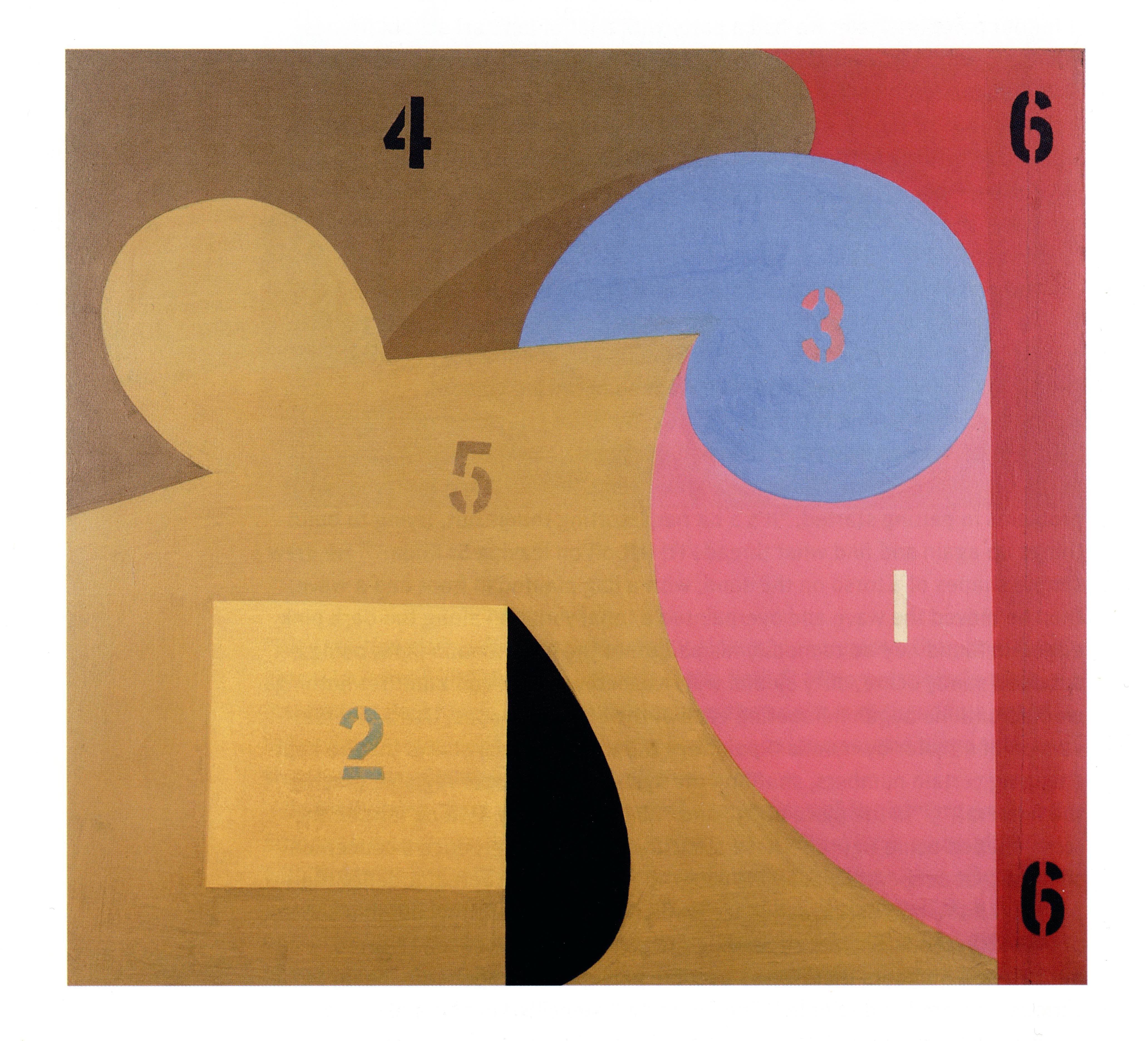
So, for example, in many of his early paintings, he's experimenting with strategies for disentangling perception from cognition. He offers us constructed conceptual systems for perceiving things differently - in a different temporal order, maybe, or in a different instinctive order. Take his Reordered Painting from 1965. Here Ian divides a nearly square canvas into six flat, hard-edged, quasi-organic colored shapes, with a number from one to six stenciled on each in a different color. As you scan the painting from left to right, the numbers are not in numerical sequence. The organic shapes lead us to perceive them in one sequence - that is, we instinctively look for the shapes that resemble human heads first. But Ian superimposes on those shapes a different, noninstinctive numerical ordering that guides the sequence in which we look at them. Or take his Left to Right Painting, also from 1965. This one is a horizontal rectangle divided into vertical bands of color of different width, from bright red to dark pink to dark grey to black moving from left to right. Here he's giving us a break, in that the instinctive perceptual sequence - left to right - is the same as the cognitive sequence for reading Indo-European languages like English. In his Blue Premiss #2 from 1966, he gives us a vertical dark blue rectangle divided by light blue lines into nine horizontal rectangles. Hung next to it on the wall is a typed verbal diagram describing possible relationships to a spectator in each of the nine rectangles. The cognitive system for perceiving the series of ruled parts of the painting is now completely detached from the painting itself and exists separately. So you read the diagram, remember the system, and then perceive each part of the painting in light of it.
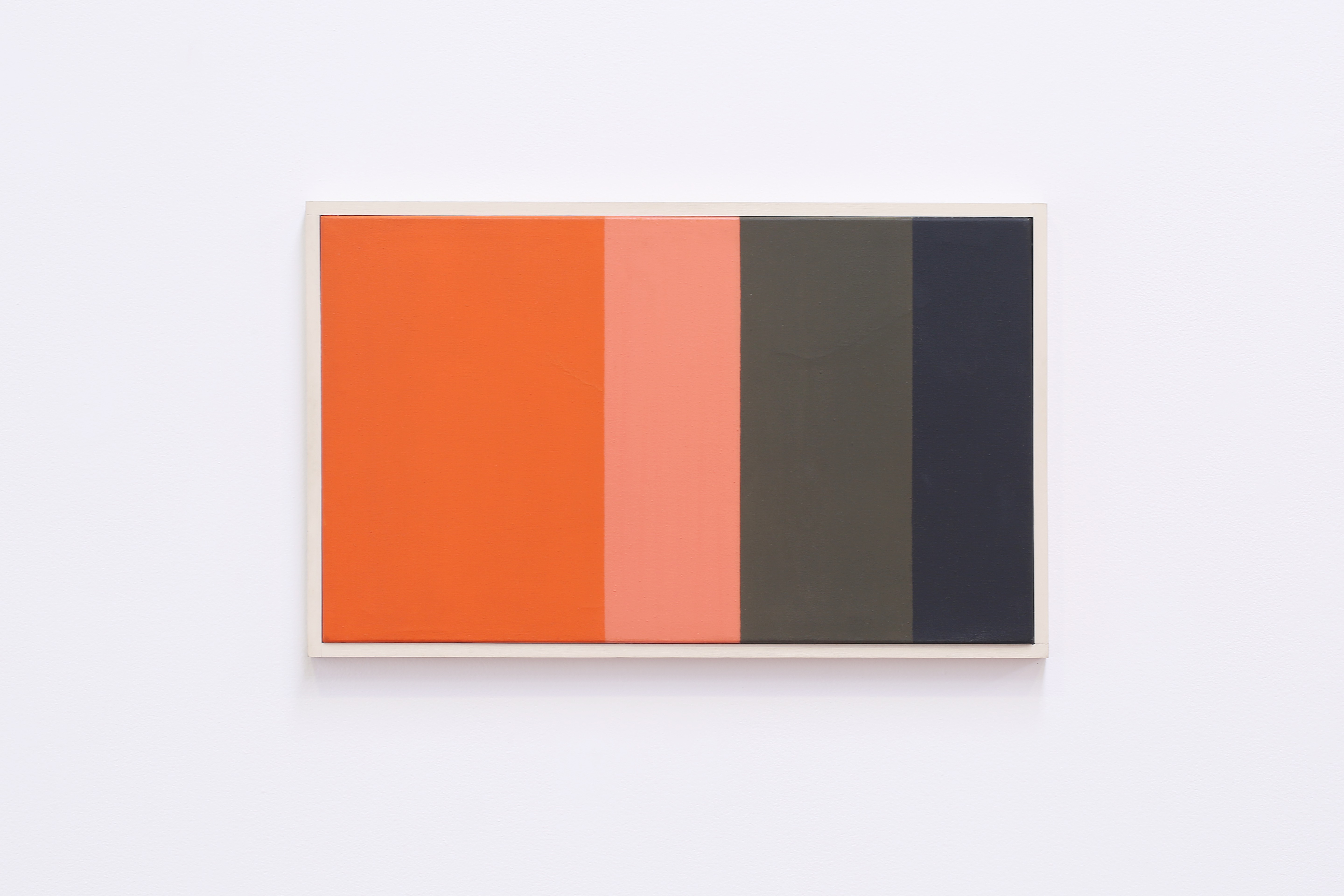
Then in the object works that follow, there's an engagement with disentangling the perceptual object viewed from the viewer's own preconceptions about it. Here he uses cognitive analysis reflexively, to redirect the viewer's perception back to her or his own situation. For example, his Blue Reflex from 1966-7 is a painting whose only express function is to reflect the viewer through the surface patina; similarly with the Mirror Piece of 1967, which raises the question of what "self-reflection" means. In this work we find a sequence of thirteen framed pages of notes and diagrams concerning the reflection and refraction of light relative to a mirror under different circumstances. At the end of the sequence is a slightly larger plain, framed mirror. The status and circumstance of the self - particularly the artist's self - is another very central theme that runs through the body of Ian's work. So here he takes this fully reflective surface, which could be a shaving mirror; puts it in a gallery context; and then presents a series of framed analyses and diagrams of its physical and refractory functions that have nothing to do with being an art object or being a utilitarian practical object. Now, my instinctive perceptual relation to a mirror is its reflection of me. If it's framed in a gallery, I tend to modify that perception according to my conception of it as an art object. But by presenting a cognitive system that's independent of both frames of reference, he disentangles it from its conventional meanings completely. Notice that he's now working with objects fabricated by other people. That continues, although not exclusively, all the way up until the last Artists Think series.
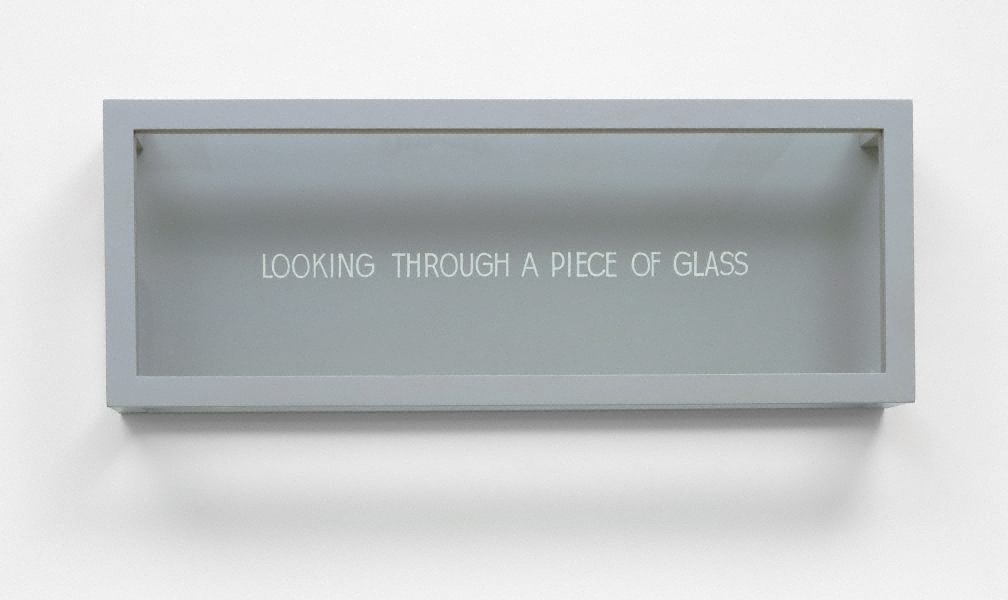
In his Undeclared Classes of 1967, he isolates these Kantian things-in- themselves even further from conventional cognitive interpretation. He takes a simple sheet of glass propped up against a wall and adds to it a framed text that explicitly and deliberately withholds any explanation of its function or context. The framed text and the unframed glass are placed so as to highlight a clear formal relationship between them. And in Looking through a Piece of Glass from 1967-8, he constructs a horizontal rectangular box with painted wood frames that hold glass panels on all sides but the rear. On the rear, painted panel there is white lettering that says, "LOOKING THROUGH A PIECE OF GLASS," which is exactly what you're doing when you read that text. So again you get this conflict between looking at the surface, looking through the surface, looking at yourself in the surface, and reading the text behind the surface, which refers you back to what's beyond the surface and which you can't possibly look at while you're reading the text. Here he's now starting to recombine the cognitive and perceptual elements he was earlier disentangling from one another, experimenting and playing with them, and with our cognitive and perceptual limitations.
Then Ian moves on to what you might call the metalevel, where he takes as a target of analysis objects made by other people that are already theory-laden by function or context, most specifically objects that have already been conceptualised as art. And he starts to disentangle our subjective preconceptions about those objects. So now you have these two strategic strands in his thinking starting to come together: the idea of reconceptualising a perceptual object according to some different cognitive system and self-reflexive scrutiny of the viewer's own preconceptions. Here you have an already-conceptualised perceptual object, where the attempt is to disentangle and rethink the viewer's own preconceptions about that. Take his Photographic Mirror (Referential Line: Sol LeWitt) from 1967-8. The object in question is a Sol LeWitt sculpture, a series of open-sided cubes constructed from wood frames painted white and placed on a floor grid. The work is conceptualised not only as art, but indeed conceptualised more specifically according to a complex geometric and permutational system. But what Ian's photographs of it show is that you can't cognise the entire system by simply perceiving it, because when you circle around it to see the whole piece, you can only get what's perceptually available from each particular location. As you're walking around it, you're never seeing the thing as it is in itself. You're always seeing perspectives on it, and the perspectives are determined not only by the system that inheres in the piece, but also by the systematic expectations you bring to it as a viewer. It's as if you try to mirror the whole work photographically by looking at it, but the work itself transcends what a perceptual device such as a mirror can do.
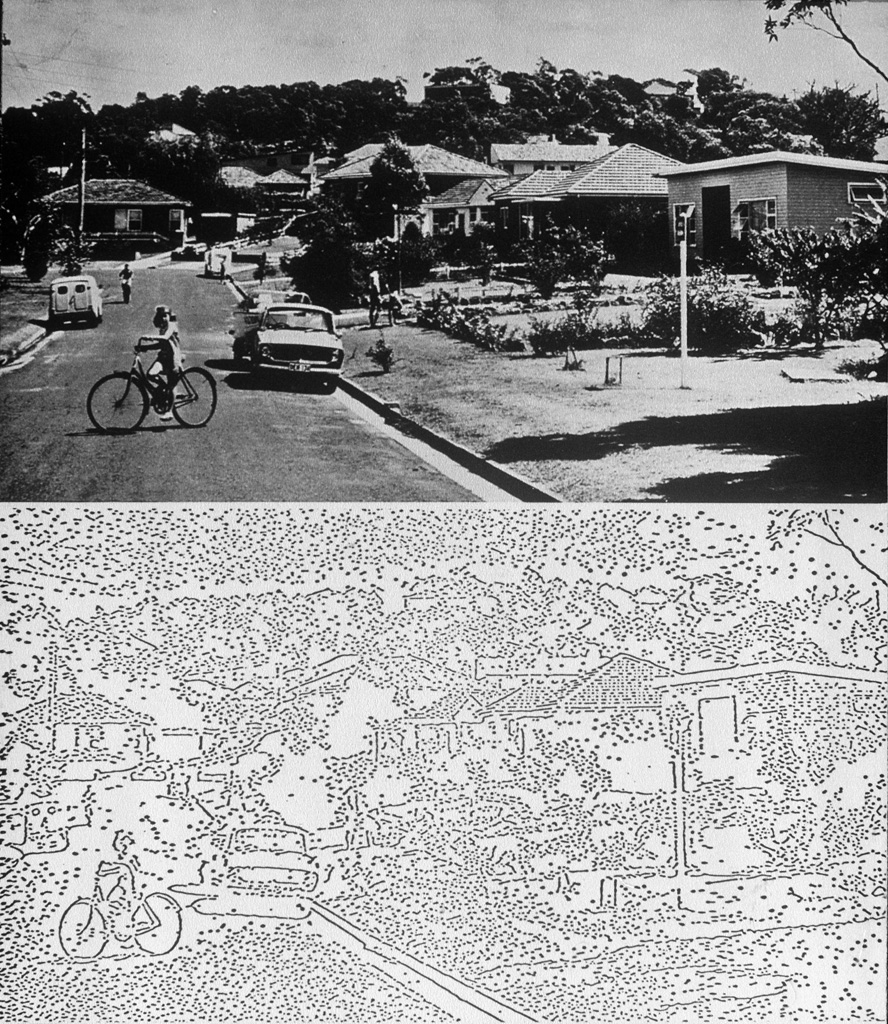
This one is called Systematically Altered Photograph: The Suburbs. Ian did this piece in 1968. What he has done is to take this photograph, apparently from an international brochure promoting tourism to Australia, depicting a clean, bright, orderly Anglo-Australian neighbourhood street, and divest it of meaning. He photocopies it, photocopies the photocopies, photocopies those photocopies, and so on, until the visual image is almost impossible to read. Through repetition it's reduced to an almost completely abstract pattern of lines and dots. So although he's still using prefabricated, conventionally conceptualised objects, here one with a graphic-arts lineage, he's now moving outside the art gallery context as such. He's working here with popular media reproductions and technology, and with explicitly social content, a set of concerns that he comes back to later on. I think it's important that he chose landscape at this time. Early on as a student he was very involved with landscape painting. But here he chooses a prefabricated landscape that is full of the marks of settlement, in a way that gives the image an impersonal, generic character, an almost stereotypical character. It could be anywhere - Sydney, San Diego, Miami. What Ian makes sure you don't get from this image is the expected idyllic, pastoral image of landscape that gives the viewer a sense of personal connection to the land. Instead you get an image of colonisation, of territory claimed by the prefabricated and impersonal architecture of a Westernised family neighbourhood. These are concerns that he repeatedly revisits.
Shortly after he did this piece, Ian began to work with the Art & Language group and do what he would describe as Conceptual art in the strict sense, where his theoretical writings function to redirect cognitively our experience of the entire art world. Now it's not just one object, it's not just one artist or one set of materials. It's the whole kit and kaboodle, all of the objects, all of the people, the institutions, the interactions. Now all of those transactions of money and power - the economic and social preconditions for producing an artwork and the effect of capitalism on it - come to occupy the focus of the cognitive lens he's imposing in order to help us rethink our perception of these realities. These writings by themselves deserve a separate discussion, but I won't give that here. I’ll just note the continuity of strategy and content: the focus on theory-laden art objects, the attempt to disentangle them cognitively from conventional and unreflective modes of interpretation, and to redirect our thinking about them through conceptual analysis.
Ian carries all of these concerns with him in his return to Australia in the late 1970s, and into his curatorial work with the Australian Labour Movement in the 1980s. Here he works with working people in many different service and industrial jobs, who produce artworks in traditional media, in a wide range of styles, that express their practical concerns and demands to other workers and management who need to hear them. He curates an exhibition of this work titled Working Art - it could as well have been called Art That Works because of its effectiveness - in which he presents this work in such a way as to cognitively redirect our thinking about political art, about traditional media, and about the relationship between personal circumstance and choice of media. And in this work he finds embodied certain values he first formulated in his earlier, Art & Language and even pre-Art & Language work.
For example, in his catalogue essay, he says, "[The] radical qualities of the art in this exhibition do not depend on any museum context or fine art criteria."8 So this is the point at which he finds the kind of work which successfully stands outside standard art-world criteria of value. It's a culmination of his progressive detachment of the object from the art environment conceptually and also experimentally in the actual works presented. He goes on, "Its primary audience is not a gallery-going audience; the art has a life outside the art gallery, and makes explicit its uses independent of any gallery setting." This was a primary concern of the work he did with the Art & Language group; the idea of transcending the art context, getting outside it completely. Here he's found a kind of art practice that does that and has brought it back in as a new paradigm. Then he goes on to say, "The ideal is a practice which doesn't privilege the artist as an individual creator, yet still demands an individual creative responsibility. It is a practice whose outcome must be vital to the labour movement, but also maintains a vitality in aesthetic terms. It is a practice which must be structurally a part of the trade union processes."9 So he's found a kind of art practice that strikes the right kind of balance between individual artist and community and overrides the distinction between art traditionally legitimated by the art world and art that has vitality and social consequence. These were all desiderata first clearly formulated in Ian's work with Art & Language. Finally he concludes, "The culture of a trade union movement is its memory, its subjective, internalised history.... But cultural programs are not about nostalgia, they are a necessary part of the strategy of trade unions. They are a way of fighting against unemployment, the indiscriminate introduction of new technology, the erosion of welfare levels and services, and of defending working conditions, wage levels and the industrial rights of working people. This art can help build a better future."10
But the importance of Ian's work here goes beyond its realisation of prior aesthetic values he brought to it. Whereas in his earlier work with theory-laden art objects he was disentangling and distancing the object from the art context, here his stance is no longer one of circling around objects but rather of full engagement with them: with the workers who produce them, the conditions under which they produce them, and the social and political consequences of producing them. That is, his relationship to them is now personal rather than impersonal. He has a working role in relation to other worker artists. He sees and uses in a socially meaningful way his ability to legitimate this art and enhance its power through the conceptual analysis he brings to it - by curating it, by writing about it, by getting us as viewers to rethink our relation to it. He presents it in such a way as to cognitively disentangle it from our conventional presuppositions both about traditional media and about political art.
This was an important realisation for many Conceptual artists in the 1970s and 1980s, that the criticism of artistic commodity production, plus a commitment to Conceptual art values didn't necessarily equal a dead-end reductionism and rejection of objects that was so radical that there was nothing to do anymore but write and talk. What Ian saw was that when you have a personal, social, and economic stake in art production as a fully engaged political subject, there's plenty to do. And so then you just get to work and do it.
And with a personal, lived involvement with the social consequences of art production, plus an awareness of his ability to further legitimate it, comes Ian's own cognitive disentanglement of the importance and power traditional media can have. Of the many compelling works exhibited in Working Art, I'll mention just a few examples. There is the Newcastle Trades Centenary Banner done in 1985. There's a poster by the Combined Unions Against Racism, also 1985. There's one by the Federated Clerks' Union of Queensland, done in 1984. There is a poster by the NSW [New South Wales] Teachers' Federation. And here's a cartoon from the AMIEU [Australasian Meat Industry Employees' Union] Newsletter from 1983. I hope this gives a sense of the diversity of people, activities, issues, media, and styles he was dealing with. This is where I would argue that he recognises the full scope of Conceptual art. This is where he sees that these media, too, when put in the service of meaningful ideas that have important consequences in the world, are no less legitimate than any others. And this makes it possible for him to take them up again and use them himself.
So now he's beginning to have a strong sense of himself as a political engaged, located agent, grounded in the same economic and social relations that ground other workers. But you can see from the range of issues he was dealing with in curating Working Art that his conception of himself could not be merely economic and social, but also had to be gendered and racial, because he was being confronted constantly with workplace issues of sexism and racism, and with workers for whom these issues were survival matters of the most pressing urgency. It's not possible to have that kind of deep, personal involvement in the issues without being forced to discover and define who you are in relation to them.
In Systematically Altered Photograph: The Suburbs from 1968 Ian had already called into question the colonised European representation of the Australian landscape as an icon of meaninglessness. And he explicitly describes the political function of European landscape painting as an "iconography of rapprochement with the land, which also symbolised the absence of traditional owners, [and] went hand in hand with the physical displacement of Aboriginal people from their land."12
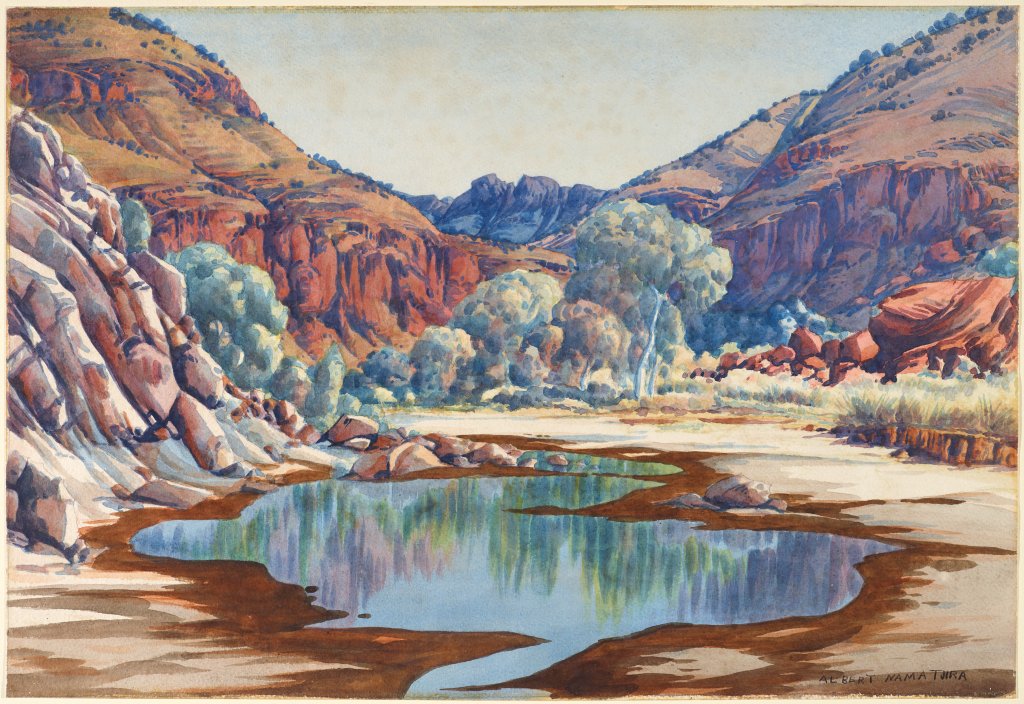
Here's Namatjira's Palm Valley from the late 1940s. His landscape watercolors had been prejudically dismissed as kitsch, as poor Europeanised imitations. In their writing about Namatjira, Ian and Ann Stephen analyse these landscapes as ways of reclaiming from the European possessive pastoral tradition the territory that in fact belong to Namatjira's own people and as ways of masking and protecting the symbolic and metaphysical meaning of that territory, by mimicking Western representational traditions. Historian Henry Reynolds published the first major study of Australian Aboriginal resistance to the European invasion of their continent. Here's what he says about the Aboriginal view of land ownership:
Ian saw that Namatjira's watercolors make a statement of fact, in a language the European viewer can understand, about who owns the land represented. I think this shows what the power of looking and representing can be under these circumstances. It's still possible to represent and appropriate, to own symbolically, conceptually and metaphysically, something that may have been subject to all sorts of legal restrictions as well as to state-imposed force. Namatjira demonstrates ownership of the land by demonstrating knowledge of the land, and even of the European representational idiom of possessing the land.
But even here Ian brings to bear, in the viewing of Namatjira's work, some of the same strategies of cognitive disentanglement he himself used in some of his own earlier object work. He points out, for example that "[t]o read these pictures comfortably we need to pre-programme our eyes to move upwards from the bottom edge - that is, to self-consciously disturb our normal Western way of seeing.''14 Echoes here of Reordered Painting (1965). And he says, "Looking again at Namatjira's picture, the self-conscious effort of pushing our eyes up into the landscape seems to make the scene more real, suggestive of being in the landscape rather than outside, detached and contemplating it." Additional echoes here of Looking through a Piece of Glass from 1967-8, as well as of his own personal evolution from detachment to involvement in Australia's social and natural landscape.
Given all this, it is in a way no surprise that Ian then revisits and squarely confronts the issue of landscape and territory as a central concern of his own work, and indeed in terms of the traditional medium of landscape painting. What else could he do, as a politically conscious and engaged white male Anglo-Australian? The issue of the ownership of territory was virtually forced on him by the trajectory of his own artistic development. It would not have been possible for him at this point even to look at the scenery around him without a theory-laden, cognitive understanding of what it meant for him to look and represent as an art of appropriation.
But at the same time that the issue of landscape had to be a compelling concern for him personally, it also had to have put him in an extremely difficult position. For one thing, in questioning Anglo-Australian ownership of the continent, he was implicitly questioning his own right to exist on it, and the right of his culture to exist on it. So he could expect a lot of resistance and accusations of betrayal from that side of the fence. Here's Kevin Gilbert again:
But not only was Ian risking accusations of betraying his own. He was also getting himself in trouble from a different direction. By articulating a position on land rights critical of Anglo-Australian hegemony and favorable to Aboriginal claims, he could be accused of presuming to speak for a community to which he didn't belong. From his work on a variety of issues in the Labour Movement, I think we can expect him to have been quite sensitive to this side of the issue as well.
So this is an issue which, on the one hand, he had to address; on the other, he had to be really quite circumspect and sensitive - completely self-reflective, really - about the position from which he addressed it, how he addressed it, and what he said. So I see him in all of this late work inching forward very carefully, toward his own solution to the question of how to name, how to articulate the political, social, economic, and aesthetic position he finds himself in as a fully situated and fully engaged Anglo-Australian white male. And I see him trying to do this in a way that preserves a sensitivity to the issues and at the same time engages honestly with them as he sees them and as he finds himself confronted with them.
His Value-Added Landscapes are based on amateur landscape paintings which he bought and collected from thrift shops. Some of them are signed, some aren't; some are more "pastoral" looking than others. Value-Added Landscape #5 (1992), for instance, has a sparse, dry look of the central Australian continent about it, whereas Value-Added Landscape #8, also from 1992, is more conventional looking. With all of them, he mounts them and then superimposes over them a sheet of transparent plexiglass with his own text, in such a way that the integrity of the original canvas is not harmed or disrupted.
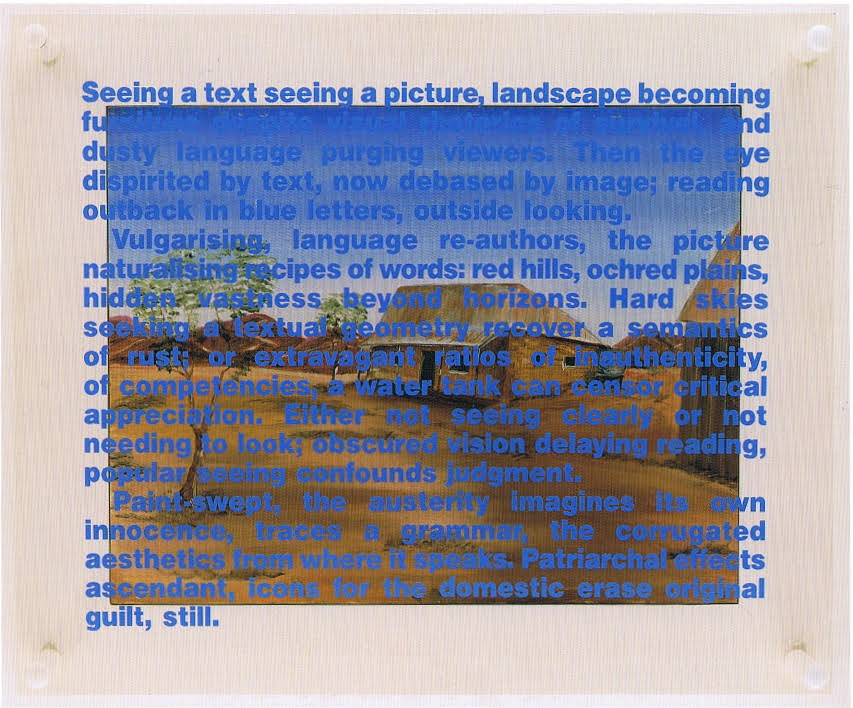
Here you can see how he's recapitulating some of the same strategies of cognitive and perceptual disentanglement he used in such earlier works as Looking through a Piece of Glass from 1967-8. And he's also again reaffirming and legitimating the use of traditional media in the service of political concepts: he's "adding value" to these landscapes by buying them, by recognising (literally, re-cognising) them, by writing about them. In the end this reaffirms his own valuation of this kind of work. And in all of these pieces I'm struck by the sense in which all of the superimposed texts contain this combination of lyrical description of physical and natural forms, full of poetic metaphor and allusion; and also a certain quite harsh and vivid political vocabulary that suggests the underlying dynamics of territoriality. There is talk of unmediated reality, of patriarchal effects ascendant; there is talk of guilt, of competencies, appreciation, globalisation, silences. He's finding a way to articulate the inherent ambivalence and conflict within his own perspective as a viewer: the conflict between its patriarchal and colonial presuppositions, and his increasingly sensitive, sophisticated, and informed political sympathies. This is exactly where a commitment to follow out the radical implications of Conceptual art should have led him.
So I'd like to close by reconsidering Ian's specific arguments that Conceptual art failed because of its irresolvable contradictions, in light of the demonstrable unity and consistency of his own practice as a Conceptual artist. In "The 1960s: Crisis and Aftermath," he asks, "[H]ow long can you use mass media forms before becoming aware of the political and economic functioning of mass media in a capitalist society?"16 I think Ian provides an answer to that in his own practice. He uses books, he uses catalogues, he uses posters, he uses prints, as an antidote to the one-dimensional capitalist representations of working conditions. The answer he gives is that you use mass media forms to change the political and economic functioning of mass media in a capitalist society. Nothing about Conceptual art in this broad sense precludes using capitalist tools to undermine capitalism, which is essentially what he was doing.
Then he goes on to ask, "How long do you need to work collectively before realising that genuinely collective work is antagonistic to the social relations of a capitalist society?" And to that I would answer, well, yes, Ian, that's exactly right; and that's why his collective work with the Labour Movement and his "collaborations" with unknown landscape painters are so effective - because of their antagonism to social relations within capitalism. We can agree that Conceptual art may have been generated historically by capitalist society, but that doesn't mean that its ideology and strategies are dependent on capitalist society.
And then he queries, "How long can you give expression to your most personal feelings within an alienating market structure before realising you are also alienating your own personal feelings?" And here the solution would be to drop out of that market structure, which is exactly what Ian did. One reason that the implications of Conceptual art are so radical is precisely because in the end they require abandoning the market that made Conceptual art possible, kind of like kicking out the ladder from under you once you reach the top. So that's not an easy thing to do. But Ian did it, and remained true to his principles. Instead of the market, he used direct political action as a medium for executing in practice the concepts that concerned him. This enabled him to reestablish personal relations both with other workers, and also with traditional media. That reconnection then made it possible for him then to return to traditional media in his own work, and, in the final Artists Think series, to himself as a landscape painter.
And finally he asks, "After you realise that the market can operate by selling ideas just as readily as it sells objects as commodities, how long can you continue to believe you are being subversive toward the market?" Well, Ian, you can buy and sell ideas that subvert the buying and selling of ideas - just as he did with the Value-Added Landscapes. Of course in the short term they become more marketable because of the imprimatur of his collaboration. But what they market is a very subversive idea of who owns the territory, who owns the environment and the land on which that market ultimately depends.
Now Ian wrote these criticisms of Conceptual art in 1981, before he started going into this later part of his own art production. He had not yet executed the art which, I have argued, resolve these problems. Even when he did start doing this work, he may not have conceived himself in the way I'm suggesting, as extending his Conceptual art practice into the political realm where I claim it inevitably leads. So he may not have conceived himself as solving the problems he raised for Conceptual art. But I would suggest that in point of fact he did solve those problems nevertheless.
This text is an edited version of the Inaugural Ian Burn Memorial Lecture, delivered July 23, 1996, at Monash University, Melbourne, and July 25, 1996, at the Museum of Contemporary Art, Sydney; sponsored by the Monash University Gallery and the Australia Council. It was originally reprinted in Art in America (December 1997): 72-79, 106. I have benefitted from discussing issues raised in this lecture with Ann Stephen, Jenepher Duncan, Judy Watson, Brenda Croft, Peter Kennedy, and Christopher Phillips. ↩
Ian Burn, Dialogue: Writings in Art History (North Sydney, NSW: Allen and Unwin, 1991): 115, 119. ↩
Ibid., 125. ↩
Ibid., 114. ↩
Sol LeWitt, "Paragraphs on Conceptual Art," Artforum V, no. 10 (Summer 1967): 79-80. ↩
Ibid. ↩
Adrian Piper, "The Logic of Modernism," Flash Art XXVI, no. 168 (lanuary-February 1993): 56-8, 118, 136. Reprinted in Out of Order, Out of Sight, Volume II: Selected Writings in Art Criticism 1967-1992 (Cambridge, MA: MIT Press, 1996). ↩
Working Art: A Survey of Art in the Australian Labour Movement in the 1980s (Sydney: Art Gallery of New South Wales, 1985): 9. ↩
Ibid., 10-11. ↩
Ibid., 15. ↩
Kevin Gilbert, Living Black (Ringwood, Victoria: Penguin Books Australia, 1978): 2. ↩
Ian Burn and Ann Stephen, "Namatjira's White Mask: A Partial Interpretation," in The Heritage of Namatjira, eds. Jane Hardy, J. V. S. Megaw, and M. Ruth Megaw (Port Melbourne, Victoria: William Heinemann Australia, 1992): 266. ↩
Henry Reynolds, The Other Side of the Frontier: Aboriginal Resistance to the European Invasion of Australia (Ringwood, Victoria: Penguin Books Australia, 1982): 65. ↩
Burn and Stephen, "Namatjira's White Mask: A Partial Interpretation," 269. ↩
Reynolds, The Other Side of the Frontier, 269. ↩
Burn, Dialogue, 118. ↩